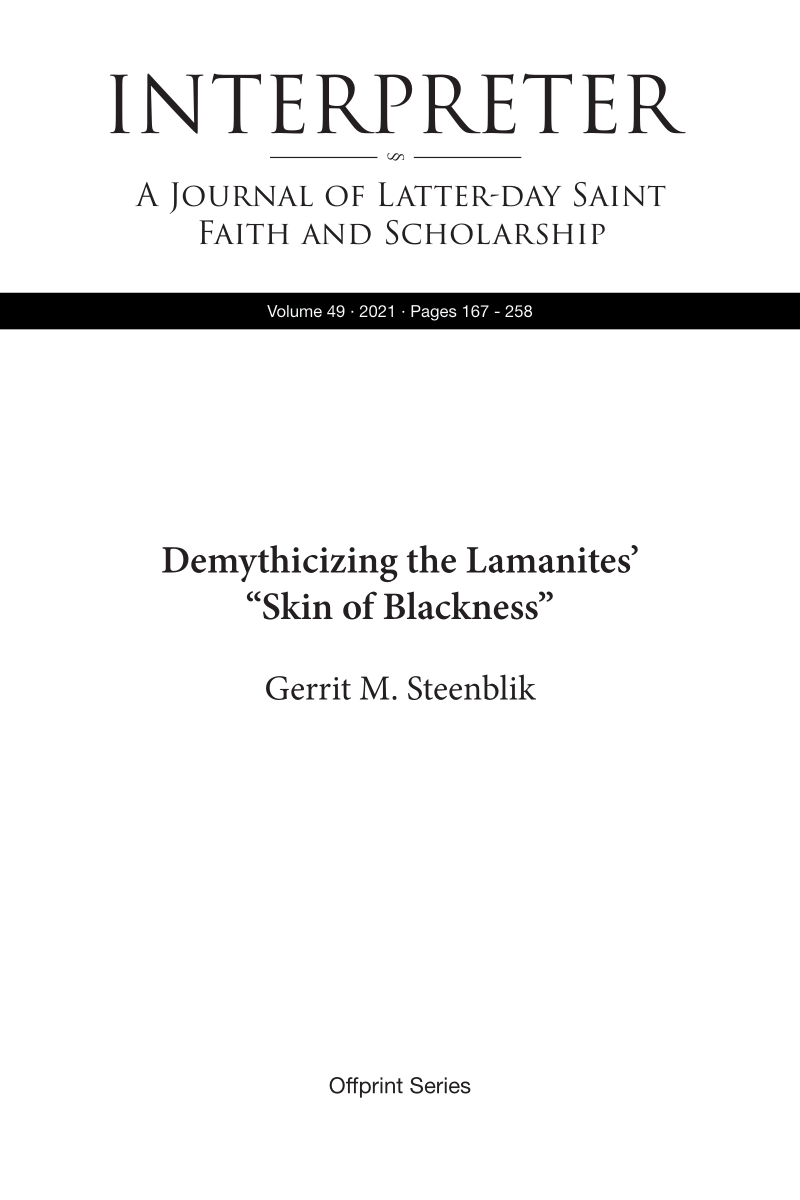Gerrit M. Steenblik argues that "blackness" in the Book of Mormon should be understood as Mayan paint.
- Type
- Academic / Technical Report
- Source
- Gerrit M. Steenblik LDS
- Hearsay
- Secondary
- Reference
Gerrit M. Steenblik, "Demythicizing the Lamanites’ 'Skin of Blackness'," Interpreter: A Journal of Latter-day Saint Faith and Scholarship 49 (2021): 172, 181-182
- Scribe/Publisher
- Interpreter: A Journal of Latter-day Saint Faith and Scholarship
- People
- Gerrit M. Steenblik
- Audience
- Reading Public
- Transcription
Relatively recent findings support a novel, promising, and fact-based explanation for the skin of blackness — the ancient Maya tradition of darkening the skin with charcoal-based body paint and stains. The hard evidence includes codices, murals, and polychrome earthenware vases and plates. This is illustrated in the detail of a Bonampak mural displayed in Sorenson’s Images of Ancient America where it appears that there is dark paint on the faces of two men in a ceremonial procession.28 Scholars Brant Gardner and Mark Wright already have suggested that the pigmentation variances shown in Maya murals might be the result of the practice of painting the skin.29 To date, however, Latter-day Saint disciple-scholars have not methodically addressed the Mesoamerican body paint artifacts and the opinions of America’s leading Mayanists who see them as evidence of a mark upon the skin that was utilitarian, episodic, artificial, and removable.
. . . .Maya art flowered during the first millennia of the Christian era (Mesoamerica’s Late Preclassic and Classic period) as Maya artisans began to produce murals and polychrome earthenware of lasting quality. Thus, surviving artifacts that display body paint postdate Lehi’s arrival, and therefore, chronologically speaking, Book of Mormon references to marks of black and red upon skins may be the earliest record of this practice. However, no one disputes that the Maya tradition originated much earlier. Effective strategies of dominant ancient societies have a long lifespan, absent abrupt environmental changes or a conquest. Artifacts confirm the enduring multi-generational body paint custom throughout the Maya realm.
The Maya also employed “scarification, cicatrization [the process of wound healing], branding, piercing, stretching, and tattooing.” Their body painting, however, was unique. It was “impermanent.” They could use it when needed and remove it at will. They could alter their appearance relatively quickly for hunting or for a military campaign, and “touch up” their black formal wear for a ceremonial occasion.
. . . .Stephen Houston, who is renowned for his research into pre-Columbian Maya civilization, has catalogued Mayan words for the body paint custom. These include naban meaning to paint oneself in the Colonial Tzotzil dialect, nabi in Ch’olti for “stain, nab in Yucatec for “anoint, smear, spot,” and in Tzendal, nabel for “makeup” and nabantezon meaning to “makeup, beautify with colors and daub with ochre.” In Colonial Yukatec, hots ich meant to work on oneself “as the Indians did anciently.” Maya body paint may have involved a common term for pigment, bon in Yukatec.
In battle, the common Maya soldier fought with little clothing other than a loincloth and body paint, which he applied before going to war. The paint allowed warriors, from a distance and up close, instantly to recognize friends and foes — a significant tactical advantage prior to the widespread development of textiles, thick clothing, and body armor. In the fog of war, and especially in hand-to-hand combat, paint was a protective mark.
- Citations in Mormonr Qnas
The B. H. Roberts Foundation is not owned by, operated by, or affiliated with the Church of Jesus Christ of Latter-day Saints.

